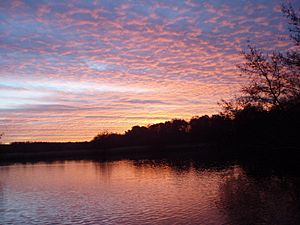Fleet Pond facts for kids
| Site of Special Scientific Interest | |
 |
|
| Area of Search | Hampshire |
|---|---|
| Interest | Biological |
| Area | 48.3 hectares (119 acres) |
| Notification | 1984 |
| Location map | Magic Map |
Fleet Pond is a large and beautiful lake in Fleet, Hampshire. It covers about 48.3 hectares (that's like 120 football fields!). It's a very special place for nature, officially called a Site of Special Scientific Interest (SSSI) and a Local Nature Reserve. This means it's protected because of its amazing wildlife and plants.
Contents
What Makes Fleet Pond Special?
Fleet Pond is a shallow lake with lots of different natural areas around it. These include:
- Reed beds: Tall plants called reeds grow in the water.
- Alder carr: A type of wet woodland with alder trees.
- Oak and birch woodland: Forests with oak and birch trees.
- Heathland: Open areas with small shrubs.
- Marsh: Wet, grassy land.
Amazing Plants and Animals
The pond is home to many different kinds of plants and animals. The water itself has a rich variety of aquatic plants and creatures. You can also find many birds here, especially wetland birds like the reed warbler. These birds love to live among the tall reeds.
A Look Back: Fleet Pond's History
Fleet Pond has a long and interesting history. It wasn't always just one big lake!
How the Pond Began
The first records of Fleet Pond are from 1324. Back then, there were actually two ponds. People used them for fishing. In olden times, a "pond" usually meant something people made, while a "lake" was natural. So, it's likely these ponds were created by building up banks at the northern edge.
From Fish to Railways
- 1491: The ponds were rented out. The person renting them had to send 100 fresh fish to Winchester every year!
- 1833: When the rental agreement was renewed, only one pond was left. The second pond was probably near a place called Ancells Farm.
- Soon after 1833: The London and Southampton Railway bought the pond. It was in the way of their new train line. They built a raised path (an embankment) across the northern part of the pond.
A Tourist Spot and Training Ground
The railway company saw that Fleet Pond could be a great place for people to visit. They even opened a special train stop called Fleet Pond Halt. This made it easy for day-trippers to come and enjoy the area.
- 1854: Much of the land around the pond became a military training area.
- 1885: As part of their training, soldiers built a long wooden bridge, about 470 meters (or 470 yards) across the pond.
Wartime and Recovery
During the Second World War, the pond was drained. This was done to make the area less visible from enemy aircraft flying overhead.
- 1947: After the war, the pond was refilled with water.
- 1947: Reeds were planted again to help the pond recover.
Protecting Fleet Pond Today
Fleet Pond has been recognized as an important natural site for a long time.
- 1951: It became one of the first Sites of Special Scientific Interest (SSSI) in Hampshire.
- 1972: The army no longer needed the land, so Hart District Council bought the pond and the surrounding heathland.
- 1976: Since then, the council has worked with a group called the Fleet Pond Society. Together, they have turned the area into a protected Local Nature Reserve.
- Today: They have even added two bridges to create a lovely circular walk all the way around the pond.
The pond gets its water from a stream called the Fleet Brook. It's a wonderful place to explore and learn about nature!

